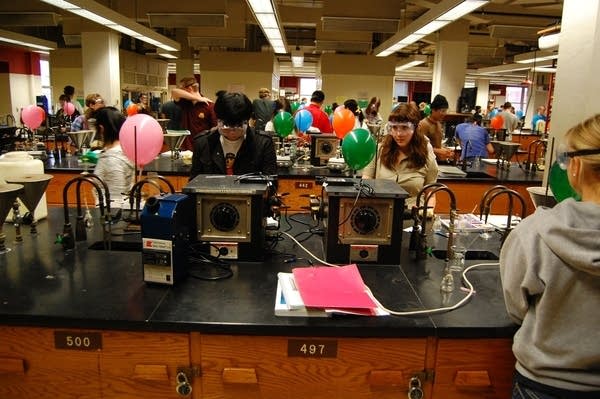In schools, even chemistry is going green
Go Deeper.
Create an account or log in to save stories.
Like this?
Thanks for liking this story! We have added it to a list of your favorite stories.

Remember working with toxic chemicals in your high school or college chemistry lab? Well, chemistry professors these days are trying some new approaches to minimize the amount of hazardous substance students are exposed to. And as schools turn to more green chemistry, the benefits could include cost savings and possibly more career options for students.
"OK so let me give you a little introduction to what we're doing today," said St. Olaf College professor Bob Hanson while getting the 16 students in his Chemistry 253 course ready to perform an experiment. "Synthesis of trans-3-Bromo-4-hydroxytetrahydrothiphene-1, 1-dioxide. Everybody get that?"
Apparently the students did get it, because after a few more instructions, they went off to collect the flasks and test tubes they needed for the experiment.
Hanson said several years ago, this experiment would have been a dangerous one.
Turn Up Your Support
MPR News helps you turn down the noise and build shared understanding. Turn up your support for this public resource and keep trusted journalism accessible to all.
"The classic way to do this is bromine with water, BR2, which is a totally noxious liquid, really hazardous material," he said.
Now the experiment is done without that hazardous material, although it still works the same.
The approach is a part of the green chemistry movement (12 principles of green chemistry), something St. Olaf College is working into its chemistry curriculum.

The college is exploring ways to use fewer toxic solvents and create less hazardous waste in its chemistry labs. Hanson said they've discovered some experiments can be done with substances as benign as water, instead of more volatile compounds.
"It almost seemed like a no-brainer," he said. "The students react to this very favorably and very much like, well 'why would you want to do this any other way? This is so obvious.'"
There are other benefits as well. Because fewer toxic reactions are being created, less energy is used to ventilate the building. St. Olaf officials say that saves the college $25,000 a year.
And they figure the school will save several thousand more dollars a year on hazardous material disposal.
The University of Minnesota is taking some similar steps in its chemistry laboratories. Jane Wissinger, the U of M's organic laboratory director, said a few years ago one common experiment was performed using a compound containing an expensive and toxic metal.

Today it's done with something much safer and cheaper.
"Now we do the reaction with household bleach," Wissinger said. "Now bleach isn't perfect, we all know it has chlorine but that's a step in the right direction."
Wissinger said chemists at the U follow other green chemistry guidelines, like working on a smaller scale to use fewer materials. But since the U of M has thousands of students in chemistry programs, that's not always possible. "Sometimes it's not, and you have to do things bigger," she said. "So you try to do things the best way you can with the least amount of harm."
Wissinger said the U's goal is to usher in more environmentally-friendly chemistry procedures, but that takes time.
There's no statewide effort in place to promote green chemistry at Minnesota's high school laboratories, but schools are exploring some aspects of the movement.

John Olson is the school improvement specialist for science at the Minnesota Department of Education. Olson said chemistry teachers are adjusting their experiments in an effort to create fewer toxic byproducts and to save money.
"You add reactants on the basis of drops rather than millimeters of stuff and you put it into small wells instead of big test tubes," Olson said. "That's been one of the approaches that some people have used to cut down partially on the expense and partially on the disposal of the chemicals."
The move toward more environmentally-friendly chemistry in schools mirrors what's happening in industry. Some companies are using green chemistry principles to develop products, like plastics, that create less waste in the manufacturing process.
One of those companies is Minnetonka-based NatureWorks, which manufactures a plastic made out of corn. Company spokesman Steve Davies said his company is pleased schools are teaching students about green chemistry.
"It's about thinking differently first about the chemistry, the reaction that's occurring but then thinking differently about beyond it," Davies said. "What are the implications?"
Davies said companies like NatureWorks know future innovations will come from students who are learning to use green chemistry in their school laboratories today.
Dear reader,
The trustworthy and factual news you find here at MPR News relies on the generosity of readers like you.
Your donation ensures that our journalism remains available to all, connecting communities and facilitating better conversations for everyone.
Will you make a gift today to help keep this trusted new source accessible to all?




